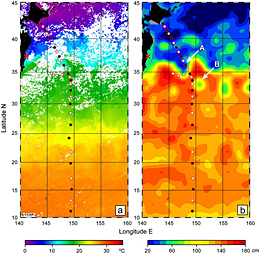Research Abstract
北太平洋黒潮続流を越えた福島原発事故由来放射性セシウムの南方への広がり
Southward spreading of the Fukushima-derived radiocesium across the Kuroshio Extension in the North Pacific
2014年3月4日 Scientific Reports 4 : 4276 doi: 10.1038/srep04276

2011年3月に起きた福島第一原子力発電所の事故によって、大量の放射性セシウムが北太平洋に放出された。その原発事故由来の放射性セシウムの鉛直分布を、2012年冬季に西部北太平洋東経149度子午線に沿った観測点で測定した。黒潮続流より南側の亜熱帯域では、深さ約300 mの亜表層で放射性セシウムの極大値が観測された。事故直後に黒潮続流の南側に降り注いだ放射性セシウムは、表面海流に沿って東向きに輸送されただけでなく、事故後約10か月以内に亜熱帯モード水の形成および沈み込みにより南向きにも輸送されたと結論できる。そのモード水に含まれる放射壊変補正済の134Csの全量は約6 PBqと見積もられ、これは北太平洋に放出された福島原発事故由来134Csの総量の10~60%に相当する。
熊本 雄一郎1, 青山 道夫2*, 浜島 靖典3, 青野 辰雄4, 纐纈 慎也1, 村田 昌彦1 & 河野 健1
- (独)海洋研究開発機構 地球環境変動領域
- 気象研究所 地球化学研究部
- 金沢大学 低レベル放射能実験施設
- 放射線医学総合研究所
* 現所属:福島大学 環境放射能研究所
The accident of the Fukushima Dai-ichi nuclear power plant in March 2011 released a large amount of radiocesium into the North Pacific Ocean. Vertical distributions of Fukushima-derived radiocesium were measured at stations along the 149°E meridian in the western North Pacific during the winter of 2012. In the subtropical region, to the south of the Kuroshio Extension, we found a subsurface radiocesium maximum at a depth of about 300 m. It is concluded that atmospheric-deposited radiocesium south of the Kuroshio Extension just after the accident had been transported not only eastward along with surface currents but also southward due to formation/subduction of subtropical mode waters within about 10 months after the accident. The total amount of decay-corrected 134Cs in the mode water was an estimated about 6 PBq corresponding to 10–60% of the total inventory of Fukushima-derived 134Cs in the North Pacific Ocean.

